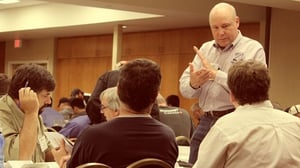This is an excerpt from Mike Parnell's analysis of OSHA's New Crane Rule: 29CFR1926.1400 Subpart CC. Click here to view Mike Parnell - Resume.
Signalperson - §1926.1428
This regulation now requires a level of knowledge that’s unprecedented in a formal way. The signalperson is required to have knowledge of crane operations and understand how a signal affects the crane’s capability and capacity. It used to be that a signalperson simply served as a separate set of eyes on the ground to help the operator get the load from Point A to Point B. Now the person in this position is more accountable to help the whole crew and to ensure the load is taken along a path that minimizes risk to others and lowers the risk to the crane.
For example, a signalperson needs to know that booming down typically loses capacity, booming up gains capacity, boom extend loses capacity, and boom retract gains capacity. This is a level of responsibility that the signalperson has not had before.
In addition, signalpersons must prove they are capable of signaling by written or oral testing and by performance. It wasn’t that long ago for the youngest, least experienced person to be assigned the task of signaling because the seasoned people were involved in rigging, blocking, and load-handling activities.
Today, at least two groups offer qualification using the certification method, and more are on the horizon. But be careful with the word ‘certified’. While a certified signalperson would meet OSHA’s requirements, OSHA only calls for a ‘qualified’ signalperson. That can be achieved in a variety of ways: Employers can offer their own documented program or candidates can be tested by a third-party evaluator, which doesn’t necessarily have to be a certifying group. The advantage of using a certifying group, however, is that the signalperson’s qualifications are portable from job to job.
One other key point: in the section on signaling, information on hand signals and radio communication has expanded, and now calls for a formal three-step process. Those steps are: 1) Function and direction, 2) distance or speed, and 3) function and stop. These steps are also identified in ASME B30.5 in the same vernacular.
However, the new regulation was not so detailed with its wording on what defines a ‘qualified’ rigger. The rule calls for a qualified rigger, but it doesn’t go much further than that.
Rigger- §1926.1401
While it’s a start that OSHA has identified the need for qualified riggers, it is unfortunate that the regulation doesn’t spell out what a qualified rigger needs to know. In 1926.1401 “qualified rigger” is defined a: a rigger who meets the criteria for a qualified person. And the definition for a “qualified person” is: a person who, by possession of a recognized degree, certificate, or professional standing, or who by extensive knowledge, training and experience, successfully demonstrated the ability to solve/resolve problems relating to the subject matter, the work, or the project. In the construction crane arena, the assembly/disassembly director must have a qualified rigger performing the rigging (see 1926.1404). Also, in the general rigging of materials on the construction site, OSHA requires the materials to be rigged by a qualified rigger (see 1926.1425).
The steel erector’s code, Subpart R, also names the rigger but goes a step further. In 1926.753(c)(2), for example, “the qualified rigger shall inspect in accordance with 1926.251,” and it talks more about the actions of the rigger throughout that entire section and how his efforts contribute to safe load handling.
I believe the biggest issue for the employer is to determine if or which of his employees meet the definition of qualified rigger. The nationally accredited certification programs have Qualified Rigger (CIC) and Rigger Level 2 (NCCCO) testing available. It appears that these do meet the intent of the OSHA requirement. Both groups offer a “basic” certification, however the candidate is not required to prove ability to solve problems, make any calculations of weights or sling tensions, nor make rigging decisions independent of a qualified rigger. So, it appears that the second tier of rigger certification by CIC and NCCCO will meet the OSHA definition.
Wire rope – § 1926.1413, § 1926.1414
Where wire rope is concerned, the new OSHA regulation includes a substantial enhancement. The old location was 1926.550(a)(7) and it was fairly limited. There are now three categories, and the new designation point is 1926.1413 and 1414.
Category I deals with physical abuse issues related to wire rope: such as crushing, kinks, and corrosion, and other things that can detrimentally affect the rope. It calls for a visual inspection each shift the ropes are used, though the inspector doesn’t have to boom the crane down to perform the inspection. Then it requires a monthly and an annual inspection, both of which are documented. The new regulation is more helpful and specific than the old requirements.
Category II has to do with broken wires and reduction of rope diameter of six-stranded and rotation-resistant ropes, and pendant lines. A big difference in the regulation is the rule on the reduction of rope diameter of more than 5 percent from nominal diameter. An adjustment will be made across the B30 volumes, with this rule. Previously, the regulation provided imperial measurements. Now, 5 percent is deemed sensible because it allows for a comparison regardless of whether the rope is imperial or metric. Almost all tower cranes use metric rope, so no imperial values would correspond to the published reference size.
Category III is for special issues related to core failure, power-line contact, or a broken strand. It’s a catch-all basket, and if these issues exist, you stop the use of the rope and see if something can be done to salvage it.
Another major change in the wire rope sections state that if these deficiencies are identified or located, it is possible to cut the rope to remove that bad section. You can’t rejoin the rope by splicing it. The whip line may get banged around and the rope chafed or some wires cut on the outside 10 feet from the headache ball. You can cut back 20 feet and reconnect the headache ball if you still have enough rope length to run the crane. A qualified person should determine if that rope is suitable to operate the crane with. You should document how much rope was removed from the end, so new inspectors and the operator realize what is left for the rope length. This was done in practice, but nothing in print ever allowed it to be done before.
Other items point the inspector in the right direction, such as change of layer points or reverse bends where the rope bends 180 degrees one way and 180 degrees another way through the sheave system. The regulation also includes a whole new section on rope selection and installation criteria. Some of the items were already implemented in B30.5 documents, based on what application the rope is going to be serving, and whether it’s a standing rope, or a running rope. It drives the industry to the manufacturer or a qualified person for help in making those decisions. The wording wasn’t in the mobile crane regulation before.
OSHA has substantially improved the overall inspection requirements for cranes. The frequency and detail will substantially help our industry by having competent and qualified persons evaluating crane components on a more regular basis
The author, Mike Parnell, is the president of Industrial Training International, Inc. ITI provides crane and rigging training/consulting for hundreds of clients in the U.S. and around the world. Mr. Parnell is the ASME B30 Main Committee Vice-Chair, a member of five B30 Subcommittees, and is a charter member of the Association of Crane & Rigging Professionals. He can be contacted at: 360-225-1100 or mike@iti.com.




COMMENTS